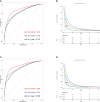Development and validation of a prognostic nomogram for bone metastasis from lung cancer: A large population-based study
- PMID: 36249042
- PMCID: PMC9561801
- DOI: 10.3389/fonc.2022.1005668
Development and validation of a prognostic nomogram for bone metastasis from lung cancer: A large population-based study
Abstract
Background: Bone is one of the most common metastatic sites of advanced lung cancer, and the median survival time is significantly shorter than that of patients without metastasis. This study aimed to identify prognostic factors associated with survival and construct a practical nomogram to predict overall survival (OS) in lung cancer patients with bone metastasis (BM).
Methods: We extracted the patients with BM from lung cancer between 2011 and 2015 from the Surveillance, Epidemiology, and End Result (SEER) database. Univariate and multivariate Cox regressions were performed to identify independent prognostic factors for OS. The variables screened by multivariate Cox regression analysis were used to construct the prognostic nomogram. The performance of the nomogram was assessed by receiver operating characteristic (ROC) curve, concordance index (C-index), and calibration curves, and decision curve analysis (DCA) was used to assess its clinical applicability.
Results: A total of 7861 patients were included in this study and were randomly divided into training (n=5505) and validation (n=2356) cohorts using R software in a ratio of 7:3. Cox regression analysis showed that age, sex, race, grade, tumor size, histological type, T stage, N stage, surgery, brain metastasis, liver metastasis, chemotherapy and radiotherapy were independent prognostic factors for OS. The C-index was 0.723 (95% CI: 0.697-0.749) in the training cohorts and 0.738 (95% CI: 0.698-0.778) in the validation cohorts. The AUC of both the training cohorts and the validation cohorts at 3-month (0.842 vs 0.859), 6-month (0.793 vs 0.814), and 1-year (0.776 vs 0.788) showed good predictive performance, and the calibration curves also demonstrated the reliability and stability of the model.
Conclusions: The nomogram associated with the prognosis of BM from lung cancer was a reliable and practical tool, which could provide risk assessment and clinical decision-making for individualized treatment of patients.
Keywords: SEER database; bone metastasis; lung cancer; nomogram; prognosis.
Copyright © 2022 Li, Guo, Zou, Alswadeh, Wang, Liu and Li.
Conflict of interest statement
The reviewer CY declared a shared parent affiliation with all authors to the handling editor at the time of review. The remaining authors declare that the research was conducted in the absence of any commercial or financial relationships that could be construed as a potential conflict of interest.
Figures



Similar articles
-
A novel nomogram predicting cancer-specific survival in small cell lung cancer patients with brain metastasis.Transl Cancer Res. 2022 Dec;11(12):4289-4302. doi: 10.21037/tcr-22-1561. Transl Cancer Res. 2022. PMID: 36644187 Free PMC article.
-
OHCCPredictor: an online risk stratification model for predicting survival duration of older patients with hepatocellular carcinoma.Hepatol Int. 2024 Apr;18(2):550-567. doi: 10.1007/s12072-023-10516-x. Epub 2023 Apr 17. Hepatol Int. 2024. PMID: 37067674 Free PMC article.
-
Nomogram Predicts Risk and Prognostic Factors for Bone Metastasis of Pancreatic Cancer: A Population-Based Analysis.Front Endocrinol (Lausanne). 2022 Mar 9;12:752176. doi: 10.3389/fendo.2021.752176. eCollection 2021. Front Endocrinol (Lausanne). 2022. PMID: 35356148 Free PMC article.
-
Prognostic Factors, Predictive Modeling, and Treatment Patterns in Breast Cancer Patients with Bone Metastasis Receiving First-Line Chemotherapy: A Population-Based Study.Ann Ital Chir. 2024;95(6):1095-1107. doi: 10.62713/aic.3807. Ann Ital Chir. 2024. PMID: 39723497
-
Nomograms for Predicting the Risk and Prognosis of Liver Metastases in Pancreatic Cancer: A Population-Based Analysis.J Pers Med. 2023 Feb 24;13(3):409. doi: 10.3390/jpm13030409. J Pers Med. 2023. PMID: 36983591 Free PMC article.
Cited by
-
What enlightenment has the development of lung cancer bone metastasis brought in the last 22 years.World J Clin Oncol. 2024 Jun 24;15(6):765-782. doi: 10.5306/wjco.v15.i6.765. World J Clin Oncol. 2024. PMID: 38946828 Free PMC article.
-
Prognostic factors and survival prediction of resected non-small cell lung cancer with ipsilateral pulmonary metastases: a study based on the Surveillance, Epidemiology, and End Results (SEER) database.BMC Pulm Med. 2023 Oct 30;23(1):413. doi: 10.1186/s12890-023-02722-y. BMC Pulm Med. 2023. PMID: 37899470 Free PMC article. Clinical Trial.
-
Competitive Risk Analysis of Prognosis in Older Adults with Sigmoid Colon Adenocarcinoma: A Population-Based Study.Cancer Control. 2024 Jan-Dec;31:10732748241262184. doi: 10.1177/10732748241262184. Cancer Control. 2024. PMID: 38868954 Free PMC article.
-
Exploring the Role of Preoperative Systemic Therapy and Primary Resection in NSCLC With Extrathoracic Metastases: Identifying the Optimal Candidates.Cancer Control. 2024 Jan-Dec;31:10732748241304973. doi: 10.1177/10732748241304973. Cancer Control. 2024. PMID: 39630939 Free PMC article.
References
LinkOut - more resources
Full Text Sources

